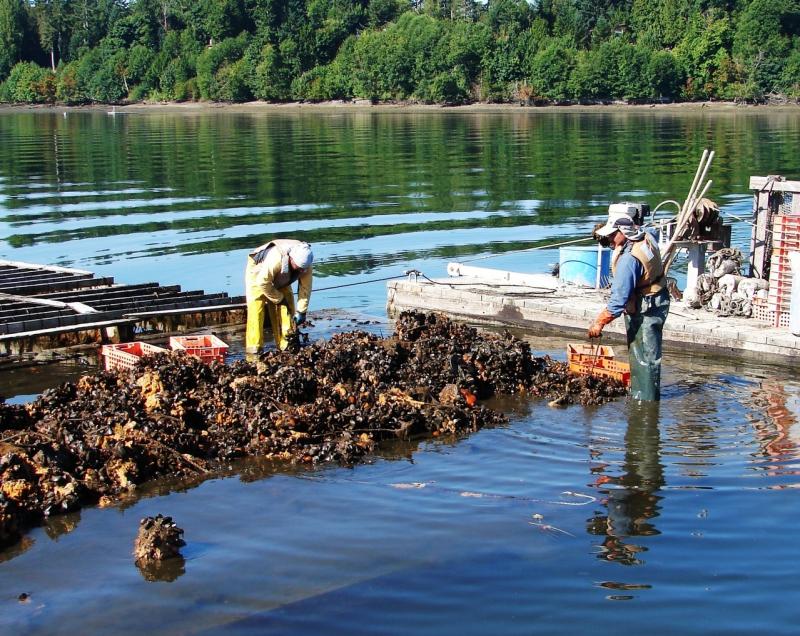
Scientists check a longline outplanting of sugar kelp at an experimental site near Coghlan Island, Alaska. Credit: Mike Stekoll, University of Alaska.
Aquaculture in the Region
In Alaska, marine aquaculture contributes to restoration efforts, and is increasing economic opportunities for coastal communities through the farming of
shellfish and seaweed. To date, commercial aquaculture activities have been relatively small-scale and have involved Pacific oysters, seaweed, blue mussels. Research activities include sea cucumbers, geoducks, and blue and red king crab. Finfish farming is prohibited by law in state waters. Currently, most farming operations are located along the coastline in either Southeast or Southcentral Alaska.
In 2016, Alaska Mariculture Initiative formed a Mariculture Task Force and laid out a comprehensive Mariculture Development Plan to accelerate the development of mariculture to grow a $100 million industry over the next 20 years. The initiative and Task Force have increased awareness and confidence in private sector investment, helping lead to a 400% increase in new farm applications to the state.
To help Alaskans advance this ambitious goal, the Alaska Regional Office and Pacific States Marine Fisheries Commission held the first NOAA Fisheries Alaska Mariculture Workshop in Ketchikan, Alaska January 21-22, 2020. The workshop brought together a wide variety of mariculture stakeholders to discuss emerging issues, identify needs related to three main topics – research, policy/permitting, and access to capital – and determine how the agency can best engage in these areas to help develop marine aquaculture in Alaska. In addition, the Alaska Fisheries Science Center has been conducting research and forming partnerships to support and expand the aquaculture within the state and connect to the national effort.
Economic Benefits of Aquaculture
Regionally, U.S. marine aquaculture is important. In many fishing and coastal communities, aquacultures creates year-round jobs, supports resilient working waterfronts and coastal communities, and provides important economic diversification opportunities.
For example, in 2019 aquaculture production sales in Alaska totaled $1.4 million.
Nationwide aquaculture production is valued at $1.5 billion and the industry also supports other sectors such as seafood processing, feed and equipment manufacturing, and food services.
Shellfish Initiative
NOAA Fisheries is working to increase populations of bivalve shellfish in coastal waters — including oysters, clams, and mussels — through commercial production and conservation activities. NOAA recognizes the broad suite of economic, social, and environmental benefits provided by increasing shellfish populations, including:
- Meeting a growing demand for seafood
- Cleaner water and nutrient removal
- Shoreline protection
- Native shellfish restoration
To maximize these ecological and economic benefits, NOAA Fisheries has increased collaboration with public and private partners to seek opportunities to streamline and enhance marine planning and permitting, environmental research, restoration and farming techniques, and innovative financing. NOAA Fisheries will continue to coordinate with other federal agencies and reach out to potential participants from industry, restoration groups, academia, states, tribes, and other stakeholders to increase shellfish production around the nation. Inspired by the national initiative, Alaska launched its own mariculture initiative in 2013 to promote the growth of aquaculture in the state.
Aquaculture by the Numbers
- Our oceans cover over 70% of the Earth’s surface, but currently account for only 2% of human food production. With limited arable land and freshwater, the world is turning to the oceans for additional food supply as global population is projected to increase to 9 billion by the year 2050.
- The U.S. aquaculture industry produced $1.5 billion worth of seafood in 2017, with 39 percent of that value coming from the Pacific region.
- Currently U.S. aquaculture focuses on high-value food species, thus the value of U.S. aquaculture production equals about 21% of the value of total U.S. seafood production, while the volume equals about 6% of the total production.
Funding Opportunities
For information about Alaska aquaculture funding opportunities, follow this link.
Contact Information
NOAA Fisheries Alaska Regional Aquaculture Coordinator

